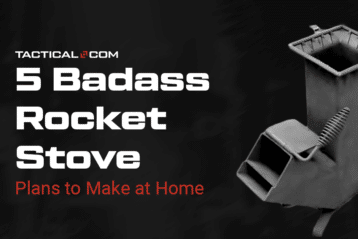
Nuclear fallout. The Black Death 2.0. A horde of hungry zombies clambering for your supplies.
You know what can protect you from all three? An underground bunker.
Underground bunkers (sometimes called bomb shelters, fallout shelters, or survival bunkers) are fool-proof ways to survive an apocalypse or two. But they don’t come easy; in fact, it takes a lot of effort, planning, and money to build a DIY underground bunker.
Curious about how to build a bunker that can put your old man’s Cold War bunker to shame? Read on:

As mentioned earlier, there are tons of bunker blueprints and layouts available all over the internet. Take a look at any of them and see what best suits you. The important thing is to cover all the crucial bases like:
You should also consider the design of your DIY underground bunker. You can choose from the popular round culvert pipe bunkers or go for the traditional, concrete-and-steel-plated square design. Each has its own pros and cons, so weigh those out carefully.
Regardless, most fallout shelters have L-shaped entrances to protect their inhabitants from gamma rays. Airtight inner doors are also the standard to keep noxious gases away and to make sure that the NBC filtration system works properly. Your doors also protect you from debris, fallout, radiation, and intruders, so make sure they’re strong. Preferably, they should be constructed from a steel frame and wood.
If you want to stay extra safe, you can construct your hatches from thick, hardened A500 steel, which is impervious to abrasions and bullets. Plus, it makes for a really badass entrance to the rest of your survival bunker.
Concrete is literally a solid choice for your DIY underground bunker. It’s strong yet relatively affordable, plus it’s easy to work with. Combine it with steel, and you have a safe and sturdy underground dwelling.
Bricks are also a good option for your bunker walls, but you also have to consider that they take some time to lay down. We don’t recommend building your survival bunker entirely out of wood because of an itty bitty issue called decomposition. But you can incorporate hardwood in some aspects of your DIY underground bunker, as in the floors and finishings.

You can’t survive without clean water, so it’s important to secure a reliable water system. Depending on how long you plan on staying in your bunker, this could range from storing gallons of water for your family until the threat passes to setting up long-term water acquisition and filtration systems.
For short-term bug-in situations, the standard is to store 2 gallons of water per person per day. For long-haul situations, it’s always best to have an underground water tank for a clean water supply.
You can also try to dig a well if your location and resources permit or use gravity to supply water to your cheap DIY underground bunker. Rainwater harvest systems are usually viable in most survival situations, but you don’t want to rely on them in case of a nuclear fallout situation.
Whichever system you choose, make sure to have a solid water filtration and purification process in place. A water system with a UV lamp allows you to purify large amounts of water at a time, but it doesn’t hurt to have backup plans like water purification tablets or iodine drops, too.
Like your water supply, your waste disposal system can go two ways: you either can go full-on bucket brigade, or you can install a more elaborate waste disposal system as in a septic tank or a composting toilet.
We don’t recommend using buckets or paint cans as makeshift toilets, but if you’re going to go that way, make sure that they’re tightly sealed by lid or a sheet of plastic. You also have to ensure that they’re sturdy and won’t leak. Lastly, strategically place them near exhaust vents to help control the odor, or dig a waste disposal pit several feet away from your bunker.
The other options are less labor-intensive. You can include a septic tank to take care of your sewage and greywater. Composting toilets, on the other hand, work by evaporating waste material and turning them into compost. These systems are used in most off-grid homesteads and can work well for your bunker.
Aside from stocking up on freeze-dried food and other non-perishables, there’s also the subject of cooking.
Assuming you’ll be in an enclosed space with little airflow, cooking with just any stove won’t be safe because of carbon monoxide. This gas will have a tough time escaping, and its fumes may eventually poison you.
You might have to live on canned food, jerky, and survival bars alone—you know, anything that doesn’t have to be cooked. Doesn’t sound appealing? Well, there IS a solution. Use an alcohol stove.
While alcohol doesn’t burn as hot as other types of fuel, it’s safe to burn indoors, and that’s really what matters most. You can choose between denatured, ethanol, or isopropyl alcohol (although denatured is best). Just take note that alcohol is highly flammable. Don’t keep your stove out of sight when you’re cooking, and stash your fuel in a secure place.
After you’ve stockpiled enough food for your family, don’t forget to load up on:
If you’re planning to stay in your bunker long-term, you might want a way to generate power. You’ve got different options for this. You can go with a generator, try solar, or—if you live in a breezy area—wind.
Once your DIY underground bunker’s done, protect it from looters by hiding it in plain sight. Cover your bunker with several inches of soil to help ward off possible radiation.
Also, plan out how you’re going to conceal entrance and exit points from the outside world. A number of folks have hidden entrances in their main house, some cover the hatch with debris, while others hide entrance and exit points in plain sight by building sheds or outhouses over the entrance points.
You’ve built an underground bunker that rivals the Batcave. That’s awesome! But you can’t call it a day yet. There’s still the small issue of maintaining your fallout shelter.
If you don’t want all your hard work—and money—to go to waste, then you’ll need to:
Wouldn’t it be ironic if the thing you built to protect you when SHTF ended up costing you your life? To avoid falling victim to a wobbly foundation or mold, check for cracks, leaks, and other forms of wear and tear every few months. Nip any issues in the bud ASAP.
Poor air quality can cause serious health problems down the line. Replace air filters and make sure your NBC air filtration system is still up and running.
What good is collecting all that food if they just end up going bad? Remember to rotate your supplies and include your bunker when you check up on your emergency food provisions.
The H2O in bottled water doesn’t go bad. But after some time, chemicals from the plastic bottle can leach into the water and harm your health. That’s why it has an expiry date. Keep tabs on this and replace your bottles if they’re about to expire. Do the same with water purification tablets.
If your bunker gets water from a well, then don’t forget to inspect it, too. It may get contaminated or completely dried up.
Once you’ve got all the components of your bunker figured out, it’s just a matter of building and installing them. Don’t have all your ducks in a row yet? No need to panic. A survival bunker is a long-term project and needs a couple of years to fully realize.
Knowing how to build a bunker is easier said than done, of course, but with patience and perseverance, you’ll have yourself a bunker that can protect you from the worst scenarios.
Already have a cheap DIY underground bunker underway? What’s your biggest challenge so far? Let us know in the comments below!
We put a lot of effort into all of the content on tactical.com. We are able to provide this content for free because we earn money for advertisements on this site. We also earn small commissions for sales generated via our affiliate links. While these commissions do earn us income, they do not cost our readers anything additional. Clicking on our ads or links helps support our staff and we sincerely appreciate your support.
Alexa is an outdoor enthusiast with years of experience camping, hiking, backpacking, and prepping for any situation. You can often find her out in the woods, or getting ready for her next challenge!



Affiliate Disclosure - Tactical.com receives compensation from affiliate partners for placing links to their products on our website. Tactical.com receives compensation for linking to these products and sometimes this influences our decision on what products we recommend or link to.
Subscribe to the Tactical.com newsletter. Get updates and free content straight to your inbox.